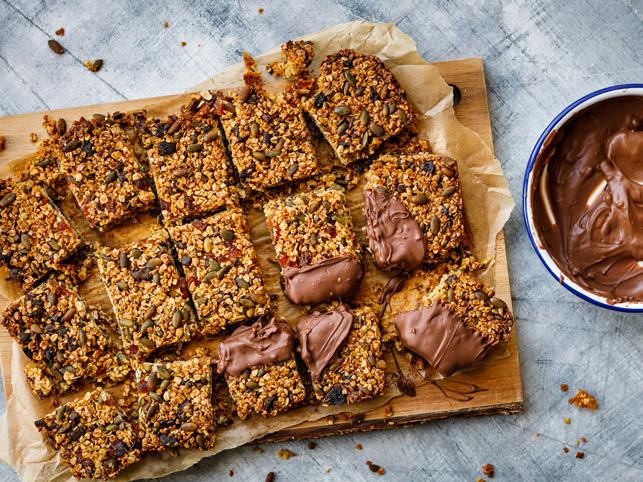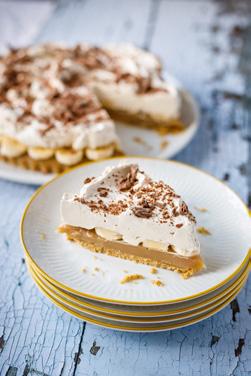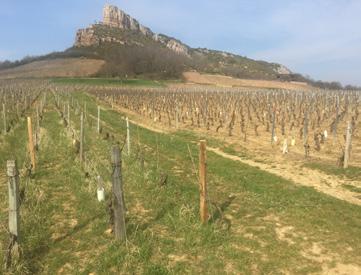
6 minute read
Out of Hours. Food & Drink Special
OUT OF HOURS GET CAKEY WITH COFFEE
CARAMEL LATTE SEEDED FLAPJACKS
Serves: 16, Preparation time: 15 mins, Cooking time: 25 minutes
What You Need
330ml Arctic Iced Coffee Caramel Latte 150g salted butter 55g soft dark brown sugar 1tbsp golden syrup 250g porridge oats 300g dried dates and apricots, chopped 100g mixed seeds
What You Do
Pre heat the oven to 180C/160C fan. Line a baking dish, approx. 25cm x 20cm with greaseproof paper.
In a saucepan bring the Arctic Iced Coffee to the boil and reduce by half the volume. Turn down the heat and add the butter, sugar and syrup to the pan. Stir until the butter and sugar are melted and all is combined.
In a bowl, mix the oats, fruit and seeds then stir in the coffee mixture.
Tip into the prepared baking dish and cook for 25 minutes until firm and golden.
CLASSIC BANOFFEE PIE
Serves: 12, Preparation time: 20 minutes plus 4 hours chilling, Cooking time: 10 minutes
What You Need
200g digestive biscuits 70g butter, melted 150g soft brown sugar 150g salted butter 397g can condensed milk 2 bananas, just ripe 150ml Arctic Iced Coffee Latte 400ml Double cream 1 flake chocolate bar
What to do:
Put the digestives in the food processor and whizz to crumbs. Pour in the melted butter and blend until combined Tip the crumbs into a 24cm loose bottomed tart tin or spring form tin and press down with the back of a spoon to make a firm, even base. Refrigerate while you make the filling.
In a saucepan melt together the butter and sugar, stirring so that they combine as they melt. Make sure the sugar is completely dissolved. Add the condensed milk and bring to the boil, reduce the heat and cook whilst stirring for a few minutes until the colour darkens slightly then remove from the heat.
20 www.birminghamlawsociety.co.uk When ready to serve, take the pie out of its tin and slide onto a serving plate.
Whip the cream to firm peaks then slowly add the Arctic Iced Coffee as you continue to whisk, bringing it back to peaks after each addition. Slice the bananas and layer them over the caramel. Spoon the coffee cream over the top and sprinkle with chocolate flake.

THE DRINK!

The times they are a-changin’ and moderation is no longer a dirty word. Whether you’re the one in charge of the car keys or just fancy an abstemious night out, here’s the answer to what to drink when you’re not drinking. Katie Sayers, Foodmarket Manager at Harvey Nichols Birmingham, reveals the most palatable alcohol-free tipples.
ORGANIC BIODYNAMIC & NATURAL WINES by Phil Innes @ Loki Wines.
Most people think they understand what Organic means, and if you are a wine drinker you may have heard the term Biodynamic. If you are a hipster you will almost certainly have heard of natural wines. I get confronted every day with people using these terms to describe wines, and I have realised that most consumers are not aware what these terms actually mean.
So, let’s start first with Biodynamic viticulture as it is probably one of the most misunderstood and often ridiculed method of organic viticulture. This is mainly due to some of the slightly crazy practices such as full moon celebrations and burying cow horns filled with manure – yes genuinely they do this. However, I have been really sold by the quality of wines that biodynamic producers usually produce. I think the fundamental principle is that if you can be bothered to bury cow horns or treat your vines with a natural tea (made from organic herbs that you have cultivated) at the crack of dawn then you probably really care about the vines, and fundamentally good grapes tend to make good wine. Just look at the two vineyards in the photo above, the one on the left is Biodynamic, and the one on the right is conventional. I know which vineyards' grapes I would like to use in my wine.
Following from that Organic viticulture is the more famous and sleeker brother of Biodynamics. As we are becoming more interested about what we put in our bodies, Organic wine has been cropping up everywhere. I have a slight problem with the certification process for organic wines as it generally favours larger producers – the fees paid to get certified cost a lot of money. Also, there are a number of non-organic products that can be used in the production of organic wine, for me although it is the most commonly recognised term it is my least favourite.
This leads me on to “natural” wine, or as some people refer it to as “minimal intervention” wine. I am really split on this style of wine, as part of me likes the romanticism of making wines as the romans made, however part of me thinks that a lot of modern techniques have certainly improved wines over the last century. The fundamental principles (although there is no legal definition) is that wines should be made as organically as possible, bottled unfined and unfiltered, and only add sulphites at bottling and in as minimal amounts as possible.
I agree that a lot of wines are now overengineered, and with the use of man-made yeast rather than natural yeast has stripped some wine of their individuality. The excessive filtering and fining of wine is certainly to the detriment of the wine. The most controversial element of the natural wine movement is certainly in the addition of SO2 which is the preservative in wine and is a naturally occurring part of the fermentation process – don’t believe anyone who says their wine is sulphite free, it’s not possible. Sulphites have been vilified for giving people headaches (it’s obviously not the alcohol) and some people are particularly sensitive to sulphites, however the amounts in most non-industrially produced wine are so minimal that you would have to be super-sensitive to have a reaction to it.
With wine we are in a privileged position that it is a generally high-end product unlike say selling potatoes, and therefore it is the responsibility of top vineyards to try to have as little impact on the environment as possible. I believe all these movements have a really important role to play in our understanding of how our consumption affects the environment. This is why I feel that if it is within your means to spend a few more pounds on something that is sustainable, rather than produced on an industrial scale I think is money well spent.
Harvey Nichols alcohol-free Sparkling Chardonnay, £10: Made from the juice of Chardonnay grapes, there are aromas of passion fruit and sweet mango which are complemented on the palate with ripe papaya and guava flavours. It finishes with a crisp, dry note of fresh lime.
Three Spirit Social Elixir alcohol-free botanical spirit, £27: This small-batch botanical alchemy of plant-based ingredients can be sipped on the rocks, topped with soda or tonic, or mixed into an alcohol-free Sour or Espresso Martini. The perfect drink for a healthy night.
Lucky Saint unfiltered alcohol-free lager, £2.50: Made from the highest quality Pilsner malt, fresh Hallertau hops and Bavarian water, this vegan-friendly beer is carefully distilled to remove the alcohol using a patented vacuum distillation process to ensure its full and distinctive flavour.
Monte Rosso alcohol-free Aperitivo, £2: This bittersweet, crisply refreshing alcoholfree drink is inspired by the classic Italian Aperitivos and crafted using spring water, wild mountain berries, summer fruits, fragrant botanicals and zesty citrus. Serve in a glass filled with ice and a slice of orange.
Borrago 47 Paloma Blend non-alcoholic spirit, £22.50: This sophisticated alcoholfree, gluten-free, allergen-free and veganfriendly botanical spirit is created using a secret blend of six herbs and spices, each individually steam distilled.
Seedlip Grove 42 alcoholfree spirit, £28.95: The third drink from the brand, Grove 42 is a zest and citrusy blend of oranges, lemon, ginger and lemongrass. It’s crafted in a similar manner to a gin, just without the alcohol – and no added sugar or sweeteners.








